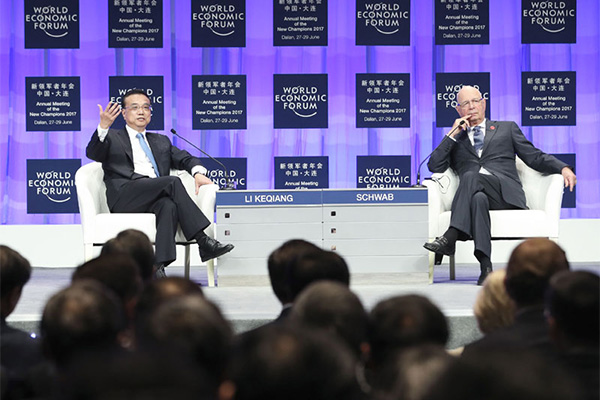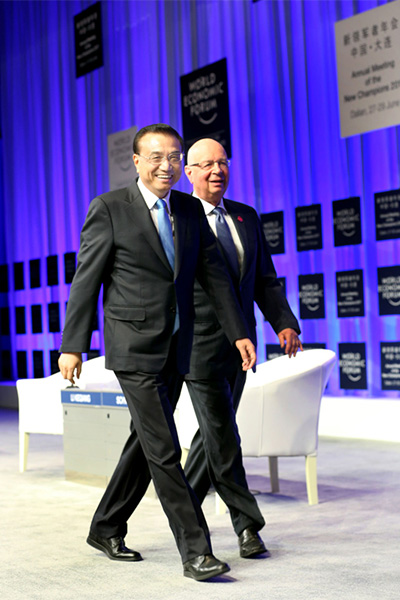
“China is demonstrating to the world its stronger power to lead the fourth industrial revolution, that is entrepreneurship and mass innovation,” said Klaus Schwab, World Economic Forum (WEF) executive chairman, at the opening of the 2017 Summer Davos Forum on June 27.
At the same event three years ago, Premier Li Keqiang put forward the concept for the first time, and cited an old Chinese saying: Great vision that makes a country prosper is but the result of collective wisdom, which comes from the people.
Schwab lauded improvements in China’s economy and its huge vigor. He cited the International Monetary Fund’s latest action as an example. On June 14, the international institution raised China’s projected GDP growth to 6.7 percent this year, from its previous estimate of 6.6 percent, the second time it raised its economic forecast for China this year.
Reuters also said that the Chinese government has explored a mature approach to entrepreneurship and mass innovation, which is becoming a new engine for the country’s economic growth.
Data showed that the number of market entities in China has increased by a daily average of 40,000 since 2014, when the initiative of mass entrepreneurship and innovation was first put forward by Premier Li.
During that period, 14,000 enterprises were registered every day, with about 70 percent of them active in business, and the number of new enterprises rose to 18,000 every day in May this year.
The emergence of various market entities has to a great extent boosted employment. According to the US’ Foreign Policy, China created more than 13 million new urban jobs for four consecutive years despite a profound adjustment in the global economy and the domestic downward pressure.

“China, once known for its cheap labor forces, has now contributed to the world in terms of innovation,” according to a report from The Wall Street Journal. Also, the “2017 global innovation index report” issued by the World Intellectual Property Organization showed that China ranked 22 in 2017, up 13 places from 2013, ranking first among all middle-income economies.
Mass entrepreneurship and innovation has brought great changes to the internal structure of the Chinese economy. In 2016, consumption served as a major driver of economic growth, making a 64.6 percent contribution.
The service sector’s added value accounted for 51.6 percent of China’s total GDP last year, and the contribution rate of science and technology rose to 56.2 percent, indicating that innovation is playing a bigger role in supporting economic development.
Analysts said that if investment, export and consumption served as engines for China’s economic growth in the past, then consumption upgrading, high-end service and high-tech undoubtedly would be the new driving forces.
A report released by the Organization for Economic Co-operation and Development said China’s structural reform has achieved positive progress, among which higher efficiency and full employment are playing an important role.
The UN General Assembly set April 21 as the world’s creativity and innovation day, and called on all countries to support mass entrepreneurship and innovation.
“Your government performed the best as far as the fourth industrial revolution is concerned,” Schwab said to Premier Li at the opening ceremony of Summer Davos, expressing his appreciation of efforts by the Chinese government.
“We dare not say we did the best, as ancient China has a saying that goes: When the moon is at its full, it begins to wane,’ but we have always been pursuing perfection,” replied the Premier.
